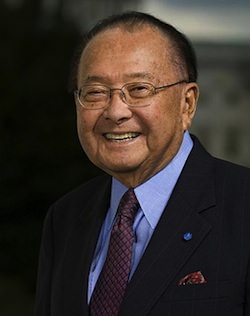An American Story: Daniel Inouye
The senator had earlier risen to be Captain Inouye, a Congressional Medal of Honor winner in Italy, losing an arm as he ran ahead of his platoon and personally destroying three German machine gun nests on a steep ridge in San Terenzo. Captain Inouye, a Congressional Medal of Honor winner in Italy, lost an arm as he ran ahead of his platoon and personally destroyed three German machine gun nests on a steep ridge in San Terenzo.
LOS ANGELES — On Feb. 1, 1943, President Franklin D. Roosevelt officially signed an order allowing Japanese-Americans to fight in the U.S. Army. Only a year earlier, the same president had signed an executive order to evacuate 120,000 Japanese and Japanese-Americans living near the West Coast into “relocation camps” in desolate, barren areas from east of the Sierra Nevada to Arkansas.
The military estimated that at least 3,000 Nisei — people of Japanese heritage born in the United States — would volunteer for active duty along with another 1,000 born in Hawaii. There were at least a thousand Nisei already in Army and Army Air Force uniform (the Navy refused to admit any Japanese-Americans), men from the West Coast and inland states providing invaluable service as translators and interrogators in the Pacific. That was more or less “top secret,” and the Japanese-Americans were accompanied everywhere by Caucasian bodyguards to protect them against being shot by their own men.The idea was that the young Japanese men would be trained as a segregated Regimental Combat Team of more than 3,000 men, serving under white officers — to be organized from Hawaii and from the internment camps across the country. In fact, more than 10,000 Hawaiians volunteered, but only 1,000 or so “mainlanders” enlisted from the camps. FDR himself called them “concentration” camps, where they and their families, from grandmothers to infants, were being held by armed American soldiers — and had essentially lost the rights of American citizenship.The Army selected 3,000 men at a huge and patriotic rally in Honolulu. One who did not make the cut was a 19-year-old pre-medical student at the University of Hawaii. He stood crying in the middle of the emptying square. “Tough luck, Danny,” said his father.But the boy did not give up, going to Army headquarters and demanding to know why he had been rejected. It turned out that medical students were deferred for their critical skills. “I’ll be back,” said the student, who went to the university and withdrew. He went back to the recruiters, and he was in the Army now. Private Daniel Inouye and the other Japanese Hawaiians and mainlanders were shipped to Fort Shelby, Miss.They hated each other. The young men from the camps were lighter-skinned, fluent in English, and sent what money they made to their families. The islanders, calling themselves “Buddhaheads,” were darker, less educated, speaking a pidgin English and raising hell and beating up mainlanders every chance they got. They called the mainlanders “Kotonks,” the sound coconuts made when they dropped to the ground. The situation was so bad that senior Army officers were talking of breaking up the untested 442nd, men with an average height of 5 foot, 4 inches who trained with toy wooden guns.Inouye, by then a sergeant, was part of a small operation that saved the 442nd. The Army sent a truckload of Buddhaheads to spend a weekend at the relocation camps in Arkansas. They were stunned to see that the families of the Kotonks were prisoners behind barbed wire. Inouye came back to Shelby and told the Hawaiians about the camps, saying, as he remembered, “Up until that point I had no idea what it was like for these men who had come from the camps. High barbed wire fences and machine gun outposts and bayoneted rifles. Would I have volunteered if I were from that camp? … I don’t know if I would have volunteered, but when we got back, they became our brothers. You know, these guys were special, that even under these extreme circumstances they would volunteer. They were better than us. … After that, the islanders and mainlanders were brothers, ready to fight and die for each other.”The rest is history. The 442nd fought with a ferocity and bravery rarely seen among American troops. Breaking through German lines, in Italy and France, taking horrendous casualties, the 442nd became the most-decorated unit of its size in American military history.© 2012 Universal Uclick
Your support matters…Independent journalism is under threat and overshadowed by heavily funded mainstream media.
You can help level the playing field. Become a member.
Your tax-deductible contribution keeps us digging beneath the headlines to give you thought-provoking, investigative reporting and analysis that unearths what's really happening- without compromise.
Give today to support our courageous, independent journalists.




You need to be a supporter to comment.
There are currently no responses to this article.
Be the first to respond.